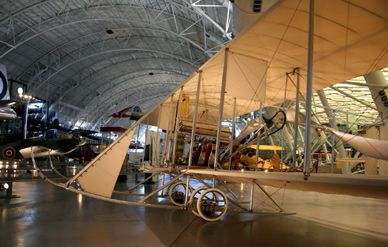Premier Performer
For their first airshows, the Wright exhibition team relied on the Model B.
/https://tf-cmsv2-smithsonianmag-media.s3.amazonaws.com/filer/ModelB-0508-631.jpg)
Although none of the Wright team's airplanes remain, visitors to the National Air and Space Museum can see two of the aircraft types flown by Wright exhibition pilots and one type flown by two of the members after the team disbanded in 1911. A reproduction 1911 Wright Model B, built by the Wright Experience and on loan to the Museum, is currently on display at the Steven F. Udvar-Hazy Center, and a Wright Model EX, the Vin Fiz, is on display at the Museum on the Mall. These airplanes' ancestors, the 1903 Flyer and the 1909 Military Flyer, are also on view at the Mall.
When the Wright brothers formed their team in 1910, they were mostly flying the Model B, a development of their Model A design of 1907. The Model A, like the 1903 Flyer and 1909 Military Flyer, was notable for the forward canard instead of a rear elevator, and skid landing gear instead of wheels. During the exhibition team's first season, the Wright B design was in transition. At first the biplane featured canard surfaces and a rear elevator, and wheels were first added in the summer of 1910. Gradually the front canard surfaces were removed until only the rear elevator remained for pitch control. These changes were incorporated into all later Model B aircraft, which was produced at the Wright factory until 1912.
The Wright Experience Model B, built using the exact specifications of the original Wright-factory-built Model B, is a duplicate of Signal Corps No. 4, the fourth airplane bought by the U.S. Army. At first glance, the reproduction airplane's wood structure might not be apparent: Wright Experience craftsmen coated every exposed wood surface with an aluminum powder polished to a lustrous shine—a camouflaging technique used by Wilbur and Orville on all their commercial airplanes. All the metal fittings have been nickel-plated, while the radiator is brass. The two seats are bright burgundy corduroy, and the rubberized cotton wings are brilliant white.
Since the reproduction Model B is not an original artifact, it can be used to educate visitors. The Museum's docents have been trained in the operation of the flight controls, and they provide numerous daily demonstrations of wing warping, elevator and rudder movement, and engine control. The engine is an original from the Wright factory; in fact, the Wright Experience Model B is airworthy and it has been flown. The authenticity of the aircraft has enabled scientific evaluation of the propellers and airfoil in wind tunnel tests, as well as dynamometer tests of the engine. Nearby is a reproduction of a Wright shipping crate, which contains items for visitors to touch and inspect closely, including one half of the bent-end propellers, a rib, a strut showing both the finished and unfinished surfaces, and samples of the fabric. The interactive Model B is scheduled be replaced by a Wright Experience-built reproduction Type A to commemorate the Wright brothers' public debut of their airplanes in 1908.
Sitting behind and to the left of the Model B is a Fowler-Gage airplane of the type that ended Wright pilot Clifford Turpin's career and cost fellow team member Philip Parmelee his life—the Fowler-Gage biplane. There were four of these airplanes known to be built, and the example at the Udvar-Hazy Center had a much more successful career than those flown by Parmelee and Turpin. It is known as the Fowler-Gage biplane after its pilot, Robert Fowler, whose most famous flight with the biplane was a coast-to-coast flight across the Isthmus of Panama in 1913. (Fowler also made the second transcontinental flight across the United States in a Wright Model B from October 1911 to February 1912.)
The Wright Model EX, known as the Vin Fiz, hangs in the Museum on the Mall's "Pioneers of Flight" gallery. The Model EX was a single-seat design similar to the Model B, and was created especially for exhibition flying. Two were known to have been built. Calbraith Rodgers made the first transcontinental flight across the United States in the Vin Fiz from September 17 to November 5, 1911. The Wright exhibition team flew the second Model EX in 1911. After the Wright team was disbanded, Parmelee and Turpin rented the machine from Wilbur and Orville and flew it in California.
The broader Wright brothers' story can be experienced in two exhibits in the Museum on the Mall: "The Wright Brothers and the Invention of the Aerial Age" and in the Early Flight gallery. The Aerial Age exhibit features the original 1903 Flyer as its centerpiece, with many unique artifacts and interactives that detail the brothers' backgrounds, their invention of the airplane, and their careers in the fledgling aviation industry. Several artifacts from the exhibition team are on view, including a field ticket from the famous Belmont Park meet. The Early Flight gallery features the 1909 Military Flyer, the first aircraft purchased by the U.S. Army. There are also models of several Wright machines, including the brothers' ill-fated racer, the Baby Grand. The Early Flight gallery also displays aircraft central to the story of the exhibition team: the competition. A Blériot XI monoplane and a Curtiss Model D "Headless Pusher" sit in close proximity to the Military Flyer—a silent reminder of the days of roaring engines, cheering crowds, and the battle for customers, prizes, and glory at the dawn of flight.
Paul Glenshaw is director of the Discovery of Flight Foundation and a freelance creative consultant, writer, and photographer. From 2000 until 2004 he was a consultant to the Wright Experience and author of Smithsonian.
